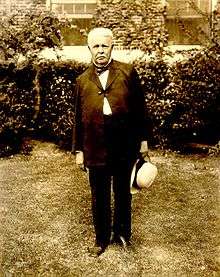Joseph D. Sayers
| Joseph Draper Sayers | |
|---|---|
 | |
| 22nd Governor of Texas | |
|
In office January 17, 1899 – January 20, 1903 | |
| Lieutenant | James Browning |
| Preceded by | Charles A. Culberson |
| Succeeded by | S. W. T. Lanham |
| Member of the U.S. House of Representatives from Texas's 9th district | |
|
In office March 4, 1893 – January 16, 1899 | |
| Preceded by | Edwin Le Roy Antony |
| Succeeded by | Albert S. Burleson |
| Member of the U.S. House of Representatives from Texas's 10th district | |
|
In office March 4, 1885 – March 3, 1893 | |
| Preceded by | John Hancock |
| Succeeded by | Walter Gresham |
| 18th Lieutenant Governor of Texas | |
|
In office 1879–1881 | |
| Governor | Oran M. Roberts |
| Preceded by | Richard B. Hubbard |
| Succeeded by | Leonidas J. Storey |
| Member of the Texas Senate | |
|
In office 1873-1874 | |
| Personal details | |
| Born |
September 23, 1841 Grenada, Mississippi |
| Died |
May 15, 1929 (aged 87) Texas |
| Political party | Democratic |
| Profession | politician, lawyer |
Joseph Draper Sayers (September 23, 1841 – May 15, 1929) was the 22nd Governor of Texas from 1899 to 1903. During Sayers's term, the Galveston Hurricane of 1900 demolished that city.
Early years
Joseph Sayers was born September 23, 1841 in Grenada, Mississippi to Dr. David Sayer and his wife Mary Thomas {Peete}. His mother died in 1851, and soon after he moved to Texas with his father and younger brother, William.[1] The family settled in Bastrop, where Sayers and his brother attended the Bastrop Military Institute.[2]
When the Civil War broke out, Sayers joined the Confederate States Army's 5th Texas Regiment, a cavalry unit led by General Tom Green. He participated in the Battle of Valverde in New Mexico in February 1862, and was recommended for promotion for his bravery in capturing an artillery battery. Later that year he returned to Texas with his regiment before being sent to Louisiana, where he was wounded in the Battle of Fort Bisland in April 1863. His actions during that conflict led to his promotion to major, and he became Green's chief–of–staff. Sayers was wounded again in April 1864 at the Battle of Mansfield. After Green died at the Battle of Blair's Landing, Sayers became the assistant adjutant to General Richard Taylor.[2]
After the war ended, Sayers returned to Texas. He opened a school and simultaneously studied law. He was admitted to the bar and then formed a partnership with G. "Wash" Jones.[2]
Public service
Sayers entered political service in 1873, when he became a state senator in the 13th Texas Legislature. In his term, he helped reverse most of the legislation that had been passed under the Radical Republicans.[2] After his term ended in 1875, Sayers spent three years as chairman of the Texas State Democratic Executive Committee. He presided over the state Democratic convention in both 1876 and 1878.[2] At the 1878 convention he was nominated to be lieutenant governor under Oran M. Roberts and later won the election. Sayers and Roberts differed on one key point; Sayers believed that public lands should be saved for homesteaders and schools, not sold cheaply to speculators, as Roberts advocated.[2]
In 1884, Sayers was elected to U.S. Congress, where he served until 1898. That year, he ran for governor, winning the election and taking office in early 1899. During his term in office, labor unions were exempted from antitrust laws, and blacklists were outlawed. His term saw increased spending on education, prisons, and social service institutions and outlawed railroad rebates.[2] He also spearheaded legislation that authorized the creation of school districts.[3]
Sayers's term was notable for the number of disasters that the state faced. The Brazos River flooded in 1899, and the following year the Galveston Hurricane of 1900 caused great devastation. Other parts of the state suffered from a severe drought, and boll weevils caused widespread cotton destruction. Millions of dollars in assistance came to the state, and Sayers administered the distribution of the funds "honestly and fairly."[3]
Later years
After leaving office in 1903, Sayers focused mainly on his law practice. He also took the time, however, to serve on the Board of Regents for the University of Texas System as well as on the Industrial Accident Board, the State Board of Legal Advisors, and the pardon board.[3]
Sayers died May 15, 1929 and is buried in Bastrop.[3]
Notes
References
- Hendrickson, Kenneth E., Jr. (1995), The Chief of Executives of Texas: From Stephen F. Austin to John B. Connally, Jr., College Station, Texas: Texas A&M University Press, ISBN 0-89096-641-9, OCLC 31243061
External links
- Works by or about Joseph D. Sayers at Internet Archive
- Joseph Draper Sayers from the Handbook of Texas Online
| Texas Senate | ||
|---|---|---|
| Preceded by Reinhard Hillebrand |
Texas Senate, District 26 1873–1874 |
Succeeded by William Hamilton Ledbetter |
| Political offices | ||
| Preceded by Richard Bennett Hubbard, Jr. |
Lieutenant Governor of Texas 1879–1881 |
Succeeded by Leonidas Jefferson Storey |
| Preceded by Charles A. Culberson |
Governor of Texas 1899–1903 |
Succeeded by S. W. T. Lanham |
| United States House of Representatives | ||
| Preceded by John Hancock |
Member of the U.S. House of Representatives from Texas's 10th congressional district 1885–1893 |
Succeeded by Walter Gresham |
| Preceded by Edwin Le Roy Antony |
Member of the U.S. House of Representatives from Texas's 9th congressional district 1893–1899 |
Succeeded by Albert S. Burleson |


